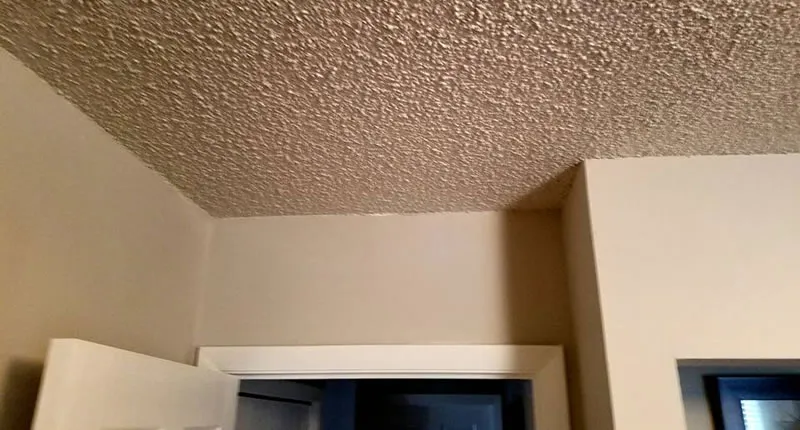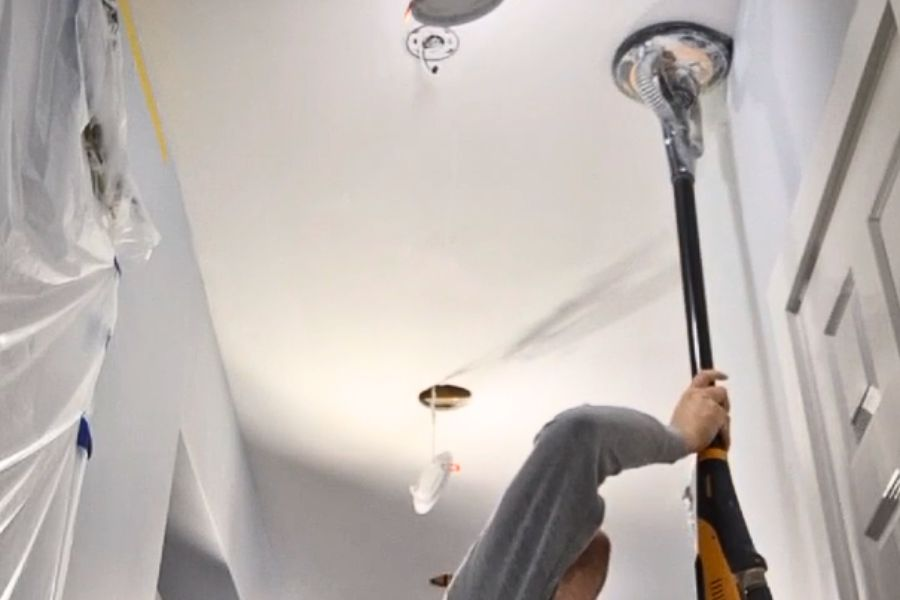Popcorn ceilings, also known as acoustic ceilings, were previously a popular feature in homes. Valued for their sound-dampening properties and their ability to hide imperfections, these textured surfaces have since fallen out of favour. Today, many homeowners find them aesthetically unpleasing and difficult to maintain. The desire to update or remove a popcorn ceiling is a common starting point for many projects. This guide offers various methods for addressing an outdated popcorn ceiling.
The Challenge of Popcorn Ceilings
The reasons for wanting to remove or cover a popcorn ceiling are often practical and aesthetic. The texture creates a surface that casts shadows, making rooms feel darker and smaller. It is also a challenge to clean, as dust and cobwebs accumulate in the crevices. Furthermore, the texture can be easily damaged, and repairs often stand out from the original finish.
Method 1: Popcorn Ceiling Removal
Popcorn ceiling removal is often considered the most desirable option for a permanent solution. The process involves scraping the textured material from the surface, revealing a smooth ceiling underneath. This method provides a clean slate for new finishes and treatments.
The Removal Process
The removal process typically begins with extensive preparation. All furniture and flooring must be protected with plastic sheeting to contain the mess. The room should be sealed off from the rest of the house to prevent dust from spreading throughout the house.
Following this is the popcorn ceiling removal process, which includes Festool popcorn texture removal, skim coat application, and priming to identify any imperfections.
Once the popcorn material is removed, the drywall may require minor repairs and sanding to achieve a smooth, professional finish.
Challenges and Safety Concerns
The most significant safety concern with popcorn ceiling removal is the potential presence of asbestos. Some homes are at a higher risk of having asbestos-containing materials. Disturbing asbestos can release dangerous fibres into the air, which can cause serious health issues if inhaled.
Before starting any removal project on a ceiling, it is crucial to have the material tested for asbestos. This is an inexpensive and straightforward process that involves sending a small sample to a certified laboratory for analysis. Homeowners should never attempt to remove a ceiling suspected of containing asbestos on their own.
When to Hire a Professional for Removal
Hiring a professional is recommended for removing popcorn ceilings. A professional contractor has the necessary experience, equipment, and safety knowledge to handle the job efficiently. The expertise of a professional is particularly valuable when the underlying ceiling requires significant repairs or when the homeowner wants a perfectly smooth, high-quality finish.
Estimated Costs and Timeframes
The cost of professional popcorn ceiling removal can vary significantly based on room location and the presence of asbestos. On average, homeowners can expect to pay between $6 and $10 per square foot to remove a popcorn ceiling. The timeframe for removal also depends on the project’s scope. A single room can often be completed in a few days, while an entire house may take a week or longer.
Method 2: Covering the Popcorn Ceiling
For those seeking a less invasive alternative to complete removal, covering the popcorn ceiling offers a viable solution. This approach avoids the mess and potential safety risks associated with scraping.
Option A: Drywalling Over the Existing Ceiling
One standard method for covering a popcorn ceiling is to install a new layer of drywall directly over the old one. This process involves attaching new drywall sheets to the existing ceiling joists. The process begins by locating the ceiling joists to ensure the new drywall is securely fastened in place. Drywall sheets are then lifted and screwed into place. The seams between the new sheets are taped and mudded, and the entire surface is sanded to create a smooth, seamless finish.
Pros: This method is generally less messy than removal and can be a less expensive option. It also results in a perfectly smooth surface.
Cons: The primary drawback is a reduction in ceiling height, typically by about 0.5 inches. The process can also be physically demanding, requiring at least two people to lift the heavy drywall sheets. It may not be suitable for homes with low ceilings.
Option B: Ceiling Panels and Planks
Another popular covering option involves installing ceiling panels or planks. These materials come in a wide range of styles, from modern PVC panels to rustic wood planks or classic tin tiles. Installation methods vary by material but typically involve attaching a grid system or directly nailing/gluing the panels to the existing ceiling. The planks and panels are designed to interlock or fit together seamlessly, hiding the popcorn texture underneath.
Aesthetic Benefits: This method offers a unique opportunity to introduce a new design element to the room. Wood planks can add warmth and character, while tin tiles can create a vintage, elegant look.
Process: The installation is often less complex than drywalling, making it a feasible project for many homeowners. However, precise measurements and careful alignment are essential for a professional finish.
Method 3: Updating Without Full Removal or Covering
For homeowners who want to update their popcorn ceiling without the expense or effort of removal or covering, a simple refresh can be achieved through painting.
Painting the Popcorn Ceiling
Painting a popcorn ceiling can be a challenging task due to its uneven texture. Proper preparation and technique are essential for achieving a good result.
The surface should be thoroughly cleaned to remove dust and cobwebs before painting. A high-quality primer is crucial, especially if the ceiling has never been painted. A stain-blocking primer is particularly effective at preventing old stains from bleeding through the new paint.
- The Right Paint: It is important to use a paint specifically designed for ceilings, which is often thicker and provides better coverage. Using a roller with a long nap, around three-quarters of an inch or more, is recommended to ensure the paint penetrates all the crevices.
- Techniques: Applying a thick, even coat is the goal. Rolling in one direction and then applying a second coat in a perpendicular direction can help achieve full coverage. A paint sprayer can also be an effective tool for achieving a smooth, consistent finish.
- Challenges: The textured surface makes it difficult to achieve an even coat, and drips can easily form. The process can be slow and requires patience.
Choosing the Right Solution for Your Home
Selecting the best method for dealing with a popcorn ceiling depends on several factors, including budget, time, skill level, and personal aesthetics.
- Budget: Popcorn ceiling removal is typically the most expensive option, especially when hiring a professional. Painting is the most budget-friendly choice. Covering with drywall or panels falls somewhere in between.
- Time and Effort: Removal is the most labour-intensive and time-consuming process. Painting is faster but still requires significant effort and care. Covering with panels or drywall is a mid-range option in terms of time and labour.
- Skill Level: Painting and some panel installations can be a suitable DIY project for a homeowner with moderate skills. However, drywalling and professional-quality removal are best left to experienced professionals to ensure a high-quality finish and safety.
- Aesthetics: If the goal is a perfectly smooth, modern ceiling, removal or drywalling is the best path. If a new texture or design element is desired, panels or planks are a great option for achieving this.
Homeowners should carefully weigh these factors, consult with a professional, and consider a consultation. An expert can assess the specific situation, including the age and condition of the ceiling, and provide a tailored recommendation.
FAQs
Is it dangerous to remove a popcorn ceiling myself?
Removing a popcorn ceiling can be dangerous, primarily due to the potential for asbestos. If a home was built before the late 1970s, the ceiling material may contain asbestos. Disturbing these materials can release harmful fibres into the air. It is crucial to have the ceiling tested before attempting to remove it. Even without asbestos, the process is messy and labour-intensive.
How much does it cost to remove a popcorn ceiling?
The cost of poiling removal varies. Professional services typically range from $6 to $10 per square foot. However, this cost can increase significantly if the ceiling contains asbestos, as specialized professionals and safety precautions are required.
Can you paint over a popcorn ceiling?
Yes, it is possible to paint over a popcorn ceiling. However, this is a challenging task due to the texture. A high-quality, thick ceiling paint applied with a long-nap roller or a sprayer is recommended to ensure proper coverage. Proper cleaning and priming are essential for a good result.
How can I tell if my popcorn ceiling contains asbestos?
The only way to confirm the presence of asbestos is through professional testing. A small sample of the ceiling material can be sent to a certified lab for analysis. Homeowners should not assume their ceiling is solely asbestos-free based on the ageeir home alone, as the material could have been installed later.
What is the easiest way to update a popcorn ceiling without a full renovation?
Painting the ceiling is often considered the easiest way to update its appearance without a full renovation. It can brighten a room and refresh the look of the ceiling without the mess or cost of removal. However, it is a temporary fix and does not change the textured surface.


